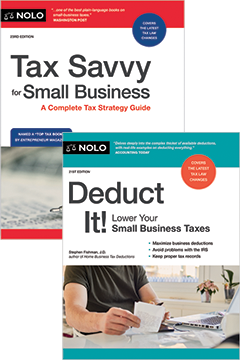Electing to be taxed as an S corporation can have tax advantages, especially with the new pass-through tax deduction created by Tax Cuts and Jobs Act.
A limited liability company (LLC) is a legal entity that has the advantages of a corporation (such as limited liability) but is easier to form and operate. All LLCs automatically receive a form of tax treatment by default. But you can elect to have your LLC treated as an S corporation, a special type of pass-through tax entity.
How LLCs Are Treated for Tax Purposes
A multi-owner LLC is automatically taxed as a partnership by default. An LLC with one owner (a single-member LLC) is taxed like a sole proprietorship or disregarded entity.
However, LLCs can choose to be taxed as a C corporation or S corporation by filing a document called an "election" with the IRS. Once this filing is done, as far as the IRS is concerned, the LLC is the same as a corporation, and it files the same tax forms as a corporation.
Most LLCs stick with their default form of taxation. Why choose an S Corporation? Because electing to be taxed as an S corporation can have tax advantages.
What Is an S Corporation?
An S Corporation isn't a type of legal entity like an LLC or a corporation that you form at the state level. Instead, an S Corp is essentially a tax status recognized by the IRS. LLCs and some corporations can elect S Corporation tax status by filing paperwork with the IRS, as discussed below.
How an LLC Taxed as an S Corp Works
Like a partnership, an S corporation is a pass-through entity—income and losses pass through the corporation to its owners' personal tax returns. S corporations also report their income and deductions much like partnerships.
An S corporation files an information return (Form 1120S) reporting the corporation's income, deductions, profits, losses, and tax credits for the year. S Corp owners must provide shareholders a Schedule K-1 listing their shares of the items on the corporation's Form 1120S. The shareholders file Schedule E with their personal tax returns (Form 1040) showing their share of corporate income or losses.
Employment Status of Business Owners
Where S corporations really differ from partnerships is the employment status of owners who work in the business. The owner of an LLC taxed as a partnership is not an employee of the LLC for tax purposes. He or she is simply a business owner.
In contrast, an S corporation owner who performs more than minor services for the corporation will be its employee for tax purposes, as well as an owner. In effect, an active owner in an S corporation wears at least two hats: as a shareholder (owner) of the entity, and as an employee of that entity.
The Social Security and Medicare tax rate for an employee is the same as for a self-employed business owner; however, it's paid differently. Half the total tax is deducted by the employer from the employee's pay, and half is paid by the employer itself. When you own the business that is paying these taxes, it makes no practical difference that half is paid by the employer—you are the employer.
Reasonable Salary Requirement
An owner/employee must be compensated for his or her services with a reasonable salary and any other employee compensation the corporation wants to provide. The owner/employee must report any S corporation's earnings on his or her personal income tax return, and pay his or her share of Social Security and Medicare taxes on any employee salary paid. The corporation must withhold federal income and employment tax from the owner/employee's pay, and pay state and federal unemployment taxes and Social Security and Medicare taxes on the employee's behalf.
Why Would an LLC File as an S Corp?
Being classified as an S corporation employee has a potentially big advantage: S corporation tax treatment can provide a way to take some money out of your business without paying employment taxes. This is because you do not have to pay employment tax on distributions (dividends) from your S corporation—that is, on earnings and profits that pass through the corporation to you as an owner, not as an employee in compensation for your services. The larger your distribution, the less employment tax you'll pay.
The S corporation is the only business form that makes it possible for its owners to save on Social Security and Medicare taxes. Historically, this has been the main reason S corporations have been popular.
For example, suppose Mel forms an LLC to operate his Bitcoin mining business and elects to have it taxed as an S corporation. Mel is an employee of the LLC and receives a $100,000 salary. The remaining $100,000 of the business's profits are passed through the S corporation and reported as an S corporation distribution on Mel's personal income tax return, not as employee salary.
Because the remaining $100,000 isn't viewed as employee wages, neither Mel nor his corporation need to pay Social Security or Medicare tax on this amount. Mel and his corporation only pay a total of $15,300 in employment taxes (15.3% x $100,000 = $15,300). Had Mel not elected S corporation status for his LLC, he would have had to pay self-employment tax on his entire $200,000 profit. This would have required him to pay an additional $2,900 in Medicare taxes and $1,252 in Social Security taxes.
If you took no salary at all, you wouldn't owe any Social Security and Medicare taxes. As you might expect, however, this is not allowed. The IRS requires S corporation shareholder-employees to pay themselves a reasonable salary—at least what other businesses pay for similar services. Moreover, due to the pass-through tax deduction discussed below, it can be advantageous for an S corporation to pay substantial employee salaries.
Pass-Through Tax Deduction
The Tax Cuts and Jobs Act established a brand new tax deduction for businesses owned through pass-through entities: sole proprietorships, partnerships, LLCs, and S corporations. Starting in 2018, owners of such entities may deduct up to 20% of their net business income from their income taxes. This is a personal deduction all pass-through business owners may take whether or not they itemize.
Limitations on the Pass-Through Deduction
You qualify for the 20% deduction only if your total taxable income for the year is less than $157,500 (single) or $315,000 (married, filing jointly). If your taxable income is greater than $207,500 (single) or $415,000 (married), you don't qualify for the pass-through deduction unless your business pays employee wages or has business property. In this event, your deduction is limited to the greater of:
- 50% of the W2 wages you pay employees, or
- 25% of wages plus 2.5% of the cost of your business property (but the deduction may never exceed 20% of your business income).
Here's one of the benefits of S corp taxation. As described above, when you elect S corporation status, you work as your business's employee and are paid W2 wages. These wages can enable you to qualify for the pass-through deduction.
Let's work through another example. Assume that Mel from the above example earned $500,000 in profit from his Bitcoin business, and that the business has no depreciable property. At this income level his pass-through deduction is limited to the greater of (1) 50% of W2 wages paid by the business, or (2) 25% of wages plus 2.5% of the cost of business property.
Mel works as an employee of his business and pays himself a salary of $200,000. He qualifies for a pass-through deduction of $100,000 (50% x $200,000 = $100,000). Had Mel not elected S corporation status, his business would have paid no W2 wages to employees and he wouldn't have qualified for any pass-through deduction.
The Pass-Through Deduction for Personal Service Business
Unfortunately, the strategy outlined above doesn't work if you are involved in a personal service business, such as:
- accounting
- law
- health
- consulting
- athletics
- financial services, and
- brokerage services.
The pass-through deduction is not available for such businesses where the owner's taxable income is over $415,000 for married individuals or $207,500 for singles. The pass-through deduction is gradually phased out for these taxpayers when their taxable income exceeds the $315,000/$157,500 thresholds. This is intended to prevent highly compensated employees who provide personal services—lawyers, for example--from having their employers reclassify them as independent contractors so they could benefit from the pass-through deduction.
How to Elect S Corporation Status
No business entity starts out with the S corporation form of taxation. Instead, you must obtain it by filing an election with the IRS. To request S corporation status, you must file Form 2553, Election by a Small Business Corporation, with the IRS. However, your business can qualify for S corporation status only if:
- your entity has no more than 100 shareholders
- none of your company's shareholders are nonresident aliens—that is, noncitizens who don't live in the United States
- your entity has only one class of stock—for example, there can't be preferred stock giving some shareholders special rights, and
- none of your company's shareholders are other corporations or partnerships.
These requirements pose no problem for most small businesses. If you want S corporation status to apply to the entire calendar year, you must file Form 2553 by March 15—the filing is retroactive to January 1.
For More Information on S Corporations
You have a lot to consider before deciding if an S Corp is the right option for your LLC. For more information, check out our articles on five questions to ask before forming an S corporation, and S corporation tax filing requirements.



